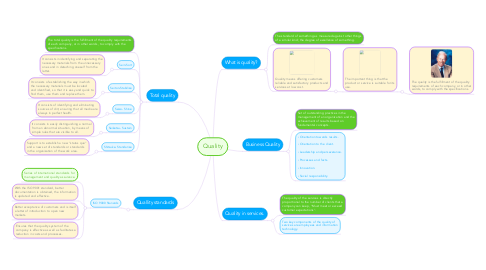
1. Total quality
1.1. The total quality is the fulfillment of the quality requirements of each company, or in other words, to comply with the specifications.
1.2. Seiri-Sort
1.2.1. It consists in identifying and separating the necessary materials from the unnecessary ones and in detaching oneself from the latter.
1.3. Seiton-Stabilize
1.3.1. It consists of establishing the way in which the necessary materials must be located and identified, so that it is easy and quick to find them, use them and replace them.
1.4. Seiso- Shine
1.4.1. It consists of identifying and eliminating sources of dirt, ensuring that all media are always in perfect health.
1.5. Seiketsu- Sustain
1.5.1. It consists in easily distinguishing a normal from an abnormal situation, by means of simple rules that are visible to all.
1.6. Shitsuke- Standarize
1.6.1. Support is to establish a new "status quo" and a new set of standards or standards in the organization of the work area.
2. Quallity standards
2.1. ISO 9000 Stanards
2.1.1. Series of international standards for management and quality assurance.
2.1.2. With the ISO 9001 standard, better documentation is obtained, the information is updated and effective.
2.1.3. Better acceptance of customers and is itself a letter of introduction to open new markets.
2.1.4. Ensures that the quality system of the company is effective as well as facilitates a reduction in costs and processes.
3. What is quality?
3.1. The standard of something as measured against other things of a similar kind; the degree of excellence of something.
3.2. Quality means offering customers reliable and satisfactory products and services at low cost.
3.2.1. The important thing is that the product or service is suitable for its use.
3.2.1.1. The quality is the fulfillment of the quality requirements of each company, or in other words, to comply with the specifications.
